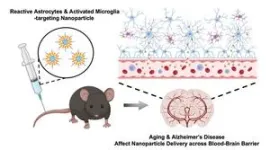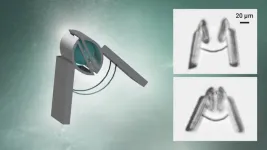(Press-News.org) Neurodegenerative disorders such as Alzheimer’s disease affect more than 270 million people worldwide. AD is the leading cause of dementia, resulting in memory loss due to atrophy of neurons in the hippocampus, which is the part of the brain that regulates learning and memory. Nanoparticles designed to carry drugs have emerged as a strategy for treating different diseases, but in the context of neurodegenerative disease, much of the research has focused on developing strategies for getting nanoparticles across the blood brain barrier and into targeted regions of the brain.
In a new study, an interdisciplinary team of researchers at the University of Illinois Urbana-Champaign have developed nanoparticles that are able to selectively bind to activated astrocytes and microglia cells that mediate brain inflammation in AD, and found that both AD and aging strongly affect the ability of nanoparticles to cross the BBB and localize to the hippocampus.
The BBB consists of a network of blood vessels surrounding the brain that tightly regulate what molecules (including drugs) can enter the brain. The BBB makes it difficult for nanoparticles carrying drugs to enter the brain, although nanoparticles can prevent the drugs from being “washed away”, or losing their activity along the way when passing through the BBB. However, research has suggested that the BBB weakens with AD and age. This inspired a team of researchers led by Joon Kong (M-CELS leader/EIRH/RBTE), a professor of chemical and biomolecular engineering, and Hee Jung Chung (M-CELS), an associate professor of molecular and integrative physiology, to synthesize a nanoparticle that could take advantage of this compromised BBB, and bind specifically to reactive astrocytes and microglia cells in the hippocampus of AD affected individuals.
“I think people have overlooked how the vascular permeability of the BBB changes with AD pathology,” said Kong. “We thought, instead of putting peptides or proteins onto nanoparticles that can help them penetrate the BBB, as others have done, let’s just make the nanoparticles small enough that they can take advantage of the leaky BBB, and engineer these particles in a way that lets them remain in the brain in a stable manner.”
The nanoparticles are designed to bind to CD44, a cell surface protein that is produced by reactive astrocytes and microglia cells, more than neurons, especially during neuroinflammation, a hallmark of AD-afflicted brain regions such as the hippocampus. The advantage of nanoparticles binding to these CD44-expressing cells is that the nanoparticles are retained longer in the hippocampus, rather than quickly being washed out, according to Kong.
The researchers injected the CD44 seeking nanoparticles into both older and younger mice that either had AD or were healthy. They then looked at the distribution of nanoparticles in the hippocampus across the treatments.
In the hippocampi of AD mice, they found high concentrations of nanoparticles regardless of age, though older AD mice had stronger concentrations than younger AD mice. The researchers say this was predicted, and further demonstrates that the BBBs of those with AD are considerably weakened. Not only were the nanoparticles able to penetrate the BBB, but they were also retained for longer in the hippocampus, for at least 2 hours post-injection, with preliminary data suggesting even longer retention.
In the brains of healthy young mice, no nanoparticles were found, meaning that their BBBs were intact. However, to the team’s surprise, they found a significant amount of nanoparticles in the brains of healthy older mice, suggesting that the BBB weakens considerably with increasing age, even in those without AD.
“This finding was surprising, because the older mice in this study are equivalent to a human age of only about 60 years old,” said Chung. “We knew there would be some leakiness of the BBB with age, but we thought there would be much less penetration of nanoparticles into the brain than we found. This highlights that there is age-dependent and disease-dependent penetration of the nanoparticles across the BBB to deep brain regions affected by AD.”
‘’This study offers valuable insights into advancing our understanding of nanoparticle transport to the brain in aging and Alzheimer's patients,” said Kai-Yu Huang, a graduate student in Kong’s lab. “It prompts us to think about the future strategies for the development of nano-scale drug carriers to target inflamed brain cells across different phases of aging-related brain disorders.’’
The next step is to try adding candidate drugs to the nanoparticles and see whether they could improve cognition and memory in AD mouse models, according to the researchers. They are also planning to measure how long their nanoparticles can be retained in the brain, which could help provide longer and more consistent drug delivery to patients treated with nanoparticles in the future. The team hopes this finding will provide a guideline for how to design drug carriers in the future for treating diseases, both within the brain and beyond.
“This extends beyond just the brain, because this technology can be used for other diseases, not just brain disease,” said Chung. “By modifying the surface moiety of nanoparticles, we can directly target different organs, given we know something specific to target within those organs. The use of nanoparticles in medicine has broad and innovative applications.”
This research was supported by the Alzheimer’s Disease Association, National Institutes of Health, the National Institute of Neurological Disorders and Stroke, the Chan Zuckerberg Biohub Chicago Acceleration Research Award, and the University of Illinois. The study can be found at https://doi.org/10.1021/acs.nanolett.3c03222
END
Nanoparticle transport across the blood brain barrier increases with Alzheimer’s and age, study finds
2024-01-04
ELSE PRESS RELEASES FROM THIS DATE:
Recent advances in medical applications of nanoparticles
2024-01-04
Nanoparticles have become an essential part of medicine, from aiding in diagnostic tests to serving as immunotherapy agents and more. Thanks to their ultrasmall size — around the thickness of a strand of DNA — these particles are adept at getting inside tissues and targeting precise areas. Here are three recent papers published in ACS journals that could expand the beneficial uses for nanoparticles, based on results in rats. The technology could be used to improve contraceptive methods, burn creams and arthritis ...
A high-tech research clinic on wheels
2024-01-04
Hispanic/Latina women with a history of hypertensive disorders of pregnancy (HDP) – conditions marked by high blood pressure during pregnancy – are more likely to have abnormalities in their heart structure and function decades later when compared with women without a history of HDP, according to a National Institutes of Health-supported study. The findings, published in the journal Hypertension, also suggest that while having high blood pressure later in life can contribute to these abnormalities, HDP play the greater role, significantly raising a woman’s risk of developing cardiovascular disease.
“The ...
Springs aboard – gently feeling the way to grasp the microcosmos
2024-01-04
These “picosprings” have remarkably large and tuneable compliancy and can be controlled remotely through magnetic fields (even deep within the human body) allowing articulated motion in microrobots as well as micromanipulations well beyond the state of the art.
Moreover, the extension of the picosprings can also be used visually to measure forces, for example propulsion or grasping forces, in interaction with other objects like cells. For example, these picosprings have been used to measure the locomotive propulsion force of sperm cells. The publication showcases these capabilities by demonstrating several ...
High folic acid and low B12 can affect fetal brain development in mice
2024-01-04
Folate is a B vitamin and a necessary nutrient to prevent neural tube defects, such as spina bifida. Folic acid, a synthetic form of folate, has been added to vitamins, breakfast cereals and other products in the U.S. and more than 80 other countries to ensure pregnant women get adequate amounts. However, new research suggests there may be such a thing as too much folic acid.
In a study published in Communications Biology, a Nature publication, researchers from the UC Davis School of Medicine and the UC Davis MIND Institute showed that imbalances in folic acid and vitamin B12 can alter brain development in mice.
“There's no doubt the introduction ...
Calibr announces license agreement with Gilead to develop a long-acting HIV antiviral agent for treatment in combination with lenacapavir
2024-01-04
LA JOLLA, CA — Calibr, the drug discovery and development division of Scripps Research, today announced Gilead Sciences, Inc. (Nasdaq: GILD) has exercised its option to exclusively license the research institute’s investigational nucleoside reverse transcriptase translocation inhibitor (NRTTI) prodrug. The NRTTI prodrug, designated GS-1614, is a development candidate resulting from a collaboration between Scripps Research and Gilead aimed at advancing a best-in-class long-acting HIV regimen.
Calibr ...
More lives can be saved if ambulance staff receive AI-support
2024-01-04
Assessing how seriously injured a person is, involves weighing up lots of different parameters fast. If healthcare professionals could get support making fast-paced, life-critical decisions from an AI tool, more lives could be saved. This is shown by research from Chalmers University of Technology in Sweden, along with the University of Gothenburg and the University of Borås.
"If severely injured people are transported directly to a university hospital, the chances of survival increase, as there are resources to take care of all types of injuries. Therefore, we need to be able to better say who is severely injured, and who is not, so ...
AURA appoints Christoph Keller as next National Solar Observatory Director
2024-01-04
The Association of Universities for Research in Astronomy (AURA) is pleased to announce that Dr. Christoph Keller has been appointed as the next Director of the National Science Foundation’s National Solar Observatory (NSO) succeeding Dr. Valentin Pillet, who will be retiring as Director in 2024. Previously Dr. Keller was Director of Science at Lowell Observatory in Flagstaff, Arizona. He will begin his five-year term on May 6, 2024.
“Christoph Keller is an outstanding choice for the next NSO Director,” ...
Pollution-tracking citizen science project offers New York students a breath of fresh air
2024-01-04
WASHINGTON, Jan. 4, 2024 – Climate change is one of the biggest issues of the 21st century, a crisis that affects the fate of the entire world as well as our place in it. A warming Earth will destroy ecosystems, flood cities, and lead to countless suffering and death for people worldwide. Part of the challenge of dealing with climate change is helping people understand its complex impacts.
In The Physics Teacher, co-published by AIP Publishing and the American Association of Physics Teachers, researchers from Fordham University partnered with middle and high schools in the Bronx and Manhattan in a citizen ...
UMass Amherst researchers bring dream of bug-free software one step closer to reality
2024-01-04
AMHERST, Mass. – A team of computer scientists led by the University of Massachusetts Amherst recently announced a new method for automatically generating whole proofs that can be used to prevent software bugs and verify that the underlying code is correct. This new method, called Baldur, leverages the artificial intelligence power of Large Language Models (LLMs), and, when combined with the state-of-the-art tool Thor, yields unprecedented efficacy of nearly 66%. The team was recently awarded a coveted Distinguished Paper award at the ...
USC Stem Cell scientists develop a game-changing organoid model to study human cerebellar development and disease
2024-01-04
In a first for USC Stem Cell scientists, the laboratory of Giorgia Quadrato, an assistant professor of stem cell biology and regenerative medicine, has pioneered a novel human brain organoid model that generates all the major cell types of the cerebellum, a hindbrain region predominantly made up of two cell types necessary for movement, cognition, and emotion: granule cells and Purkinje neurons. This marks the first time that scientists have succeeded in growing Purkinje cells that possess the molecular and electrophysiological features of functional neurons in an all-human system. These breakthroughs in organoid-directed brain modeling have been published recently ...






